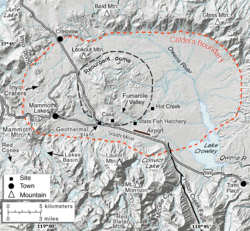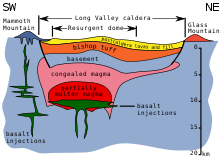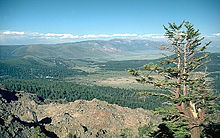Long Valley Caldera
The Long Valley Caldera is located in the eastern part of the U.S. state of California on the border with Nevada, in Mono County about 25 km south of Mono Lake. It is an active volcanic area that collapsed due to a violent explosive volcanic eruption 760,000 years ago over an area of 544 km² (about 32 km by 17 km east-west or north-south extent) and is sunken about 300 m to 1000 m from its present surroundings. The Long Valley Caldera is one of the largest calderas on earth and the second largest caldera in the USA after Yellowstone. During the plinian eruption of the supervolcano 1400 km³ of rhyolitic ash and pyroclastics were ejected within six days. The 3300 km³ to 6600 km³ magma chamber still contains 900 to 1400 km³ of rhyolitic melt.
Even today there are frequent earthquakes and gas emissions in the area of the Long Valley Caldera. To the west and north of the caldera are the active Inyo Craters, part of the Mono-Inyo Craters, which are volcanically related to the caldera. For this reason, the US Geological Survey maintains its own observatory, the Long Valley Observatory (LVO), to study and monitor the activity of the caldera and to be able to warn the population in case of signs of an imminent eruption.
The caldera forms the upper, northern end of the Owens Valley, between the Sierra Nevada to the west and the White Mountains to the east. The Owens River and its tributary Hot Creek originate in it. Lake Crowley, the reservoir on the Owens River, lies entirely within the southern part of the caldera. Land is almost entirely federally owned except in the settlements and at Lake Crowley and is part of the Inyo National Forest, a national forest administered by the United States Forest Service. In the caldera are the towns of Mammoth Lakes and Crestview. The valley is served by U.S. Highway US 395.
Since 1941, surface water from the Mono Lake catchment area north of the caldera has been piped south through the Long Valley Caldera into the Owens Valley and, with most of the water from its catchment area, into the Los Angeles Aqueduct. It supplies drinking water to the city of Los Angeles, about 450 km away.
To the southeast outside the caldera proper are the Volcanic Tablelands. The bedrock there is tuff, formed from volcanic ash ejected from the Long Valley Caldera. The landscape with steep to vertical wall structures eroded from this rock.

Relief map of the Long Valley Caldera, California. The edge of the caldera is indicated by the red line. Source: Long Valley Observatory (LVO) of the USGS.

Geological profile through the Long Valley Caldera.

View of the north-eastern rim of the caldera from the west
Questions and Answers
Q: What is Long Valley Caldera?
A: Long Valley Caldera is a depression in east California next to Mammoth Mountain, which is one of the Earth's largest calderas resulting from a gigantic volcanic explosion.
Q: When did Long Valley Caldera form?
A: Long Valley Caldera formed 760,000 years ago as a result of a supervolcanic eruption.
Q: How big is Long Valley Caldera?
A: Long Valley Caldera is about 20 miles (32 km) long (east-west), 11 miles (18 km) wide (north-south), and up to 3,000 feet (910 m) deep.
Q: What is Bishop tuff?
A: Bishop tuff is a type of rock formation that is common to the Long Valley Caldera area. It was formed from very hot ash released during the supervolcanic eruption.
Q: Is Long Valley Caldera expected to explode again?
A: No, Long Valley Caldera is not expected to explode again in such a manner.
Q: How much material was released during the Long Valley Caldera eruption?
A: The Long Valley Caldera eruption released 600 cubic kilometres (140 cu mi) of material from vents inside the margin of the caldera, which is a significantly larger amount compared to the 1980 Mount St. Helens eruption.
Q: What happened to three members of the Mammoth Mountain Ski Area ski patrol in April 2006?
A: Three members of the Mammoth Mountain Ski Area ski patrol died from suffocation by carbon dioxide when they fell into a fumarole on the slopes of the mountain while attempting to fence it off.
Search within the encyclopedia